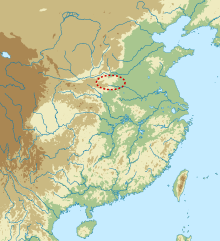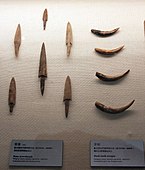
Jiahu was the site of a Neolithic settlement based in the central plain of ancient China, near the Yellow River. It is located between the floodplains of the Ni River to the north, and the Sha River to the south, 22 km (14 mi) north of the modern city of Wuyang, Henan Province. Most archaeologists consider the site to be one of the earliest examples of the Peiligang culture. Settled around 7000 BC, the site was later flooded and abandoned around 5700 BC. The settlement was surrounded by a moat and covered a relatively large area of 55,000 square meters. At one time, it was "a complex, highly organized Chinese Neolithic society", home to at least 250 people and perhaps as many as 800.

The Yangshao culture was a Neolithic culture that existed extensively along the middle reaches of the Yellow River in China from around 5000 BC to 3000 BC. The culture is named after the Yangshao site, the first excavated site of this culture, which was discovered in 1921 in Yangshao town, Mianchi County, Sanmenxia, western Henan Province by the Swedish geologist Johan Gunnar Andersson (1874–1960). The culture flourished mainly in the provinces of Henan, Shaanxi and Shanxi.

The Longshanculture, also sometimes referred to as the Black Pottery Culture, was a late Neolithic culture in the middle and lower Yellow River valley areas of northern China from about 3000 to 1900 BC. The first archaeological find of this culture took place at the Chengziya Archaeological Site in 1928, with the first excavations in 1930 and 1931. The culture is named after the nearby modern town of Longshan in Zhangqiu, Shandong. The culture was noted for its highly polished black pottery. The population expanded dramatically during the 3rd millennium BC, with many settlements having rammed earth walls. It decreased in most areas around 2000 BC until the central area evolved into the Bronze Age Erlitou culture. The Longshan culture has been linked to the early Sinitic . According to the area and cultural type, the Longshan culture can be divided into two types: Shandong Longshan and Henan Longshan. Among them, Shandong Longshan Cultural Site includes Chengziya Site; Henan Longshan Cultural Site includes Dengfeng Wangchenggang Site in Wangwan, Taosi Site and Mengzhuang Site in Hougang.
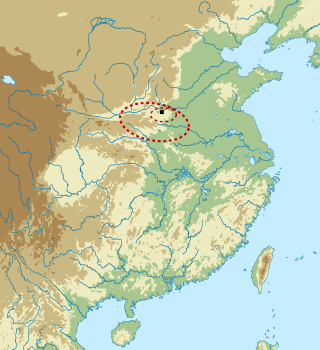

The Dawenkou culture was a Chinese Neolithic culture primarily located in the eastern province of Shandong, but also appearing in Anhui, Henan and Jiangsu. The culture existed from 4300 to 2600 BC, and co-existed with the Yangshao culture. Turquoise, jade and ivory artefacts are commonly found at Dawenkou sites. The earliest examples of alligator drums appear at Dawenkou sites. Neolithic signs, perhaps related to subsequent scripts, such as those of the Shang dynasty, have been found on Dawenkou pottery.

The Majiayao culture was a group of neolithic communities who lived primarily in the upper Yellow River region in eastern Gansu, eastern Qinghai and northern Sichuan, China. The culture existed from 3300 to 2000 BC. The Majiayao culture represents the first time that the upper Yellow River region was widely occupied by agricultural communities and it is famous for its painted pottery, which is regarded as a peak of pottery manufacturing at that time.

Banpo is an archaeological site discovered in 1953 by Shi Xingbang, and located in the Yellow River Valley just east of Xi'an, China. It contains the remains of several well organized Neolithic settlements, like Jiangzhai, carbon dated to 6700–5600 years ago. The area of 5 to 6 hectares is surrounded by a ditch, probably a defensive moat, 5 to 6 meters wide. The houses were circular, built of mud and wood with overhanging thatched roofs. They sat on low foundations. There appear to be communal burial areas.

Proto-writing consists of visible marks communicating limited information. Such systems emerged from earlier traditions of symbol systems in the early Neolithic, as early as the 7th millennium BC in China and Southeastern Europe. They used ideographic or early mnemonic symbols or both to represent a limited number of concepts, in contrast to true writing systems, which record the language of the writer.
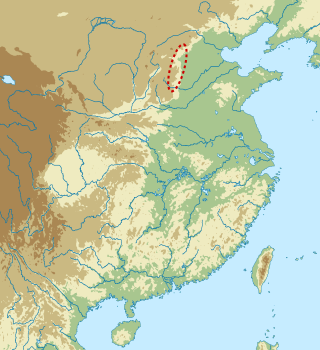
Nanzhuangtou, dated to 12,600–11,300 cal BP or 11,500–11,000 cal BP, roughly 9,500–9,000 BC, or 10,700–9,500 BP, roughly 8,700–7,500 BC, is an Initial Neolithic site near Lake Baiyangdian in Xushui County, Hebei, China. The site was discovered under a peat bog. Over 47 pieces of pottery were discovered at the site. Nanzhuangtou is also the earliest Neolithic site yet discovered in northern China. There is evidence that the people at Nanzhuangtou had domestic dogs 10,000 years ago. Stone grinding slabs and rollers and bone artifacts were also discovered at the site. It is one of the earliest sites showing evidence of millet cultivation dating to 10,500 BP. Pottery can also be dated to 10,200 BP.

The Pengtoushan culture was a Neolithic culture located around the central Yangtze River region in northwestern Hunan province, China. It dates to around 7500–6100 BC, and was roughly contemporaneous with the Peiligang culture to the north. It is named after the type site at Pengtoushan.

The Beixin culture was a Neolithic culture in Shandong, China. It was the successor of the Houli culture and precursor of the Dawenkou culture.

The Houli culture was a Neolithic culture in Shandong, China. The people of the culture lived in square, semi-subterranean houses. The most commonly found artefacts at Houli sites are pottery and stone tools. Jade artefacts and bone, antler, shell tools were also found at Houli sites. While the remains of domesticated dogs and pigs in the early stages of domestication were found at some sites associated with the culture, the people of the Houli culture relied mostly on hunting and fishing. The remains of rice, broomcorn millet, and foxtail millet were discovered at Houli sites.
The Jiahu symbols are a corpus of distinct markings on prehistoric artifacts found in Jiahu, a neolithic Peiligang culture site found in Henan, China, and excavated in 1989. The Jiahu symbols are dated to around 6000 BC. Although at first a total of 16 signs were identified, intensive scrutiny has found there to be only 11 definitely incised signs, of which 9 were incised on tortoise shells and an additional 2 on bone. The archaeologists who made the original finds believed the markings to be similar in form to some characters used in the much later oracle bone script, but most doubt that the markings represent systematic writing. A 2003 report in Antiquity interpreted them "not as writing itself, but as features of a lengthy period of sign-use which led eventually to a fully-fledged system of writing". The earliest known body of writing in the oracle bone script dates much later to the reign of the late Shang dynasty king Wu Ding, which started in about c. 1250 BC or 1200 BC.
Since the second half of the 20th century, inscriptions have been found on pottery in a variety of locations in China, such as Banpo near Xi'an, as well as on bone and bone marrows at Hualouzi, Chang'an County near Xi'an. These simple, often geometric, marks have been frequently compared to some of the earliest known Chinese characters appearing on the oracle bones, and some have taken them to mean that the history of Chinese writing extends back over six millennia. However, only isolated instances of these symbols have been found, and they show no indication of representing speech or of the non-pictorial processes that a writing system requires.
The archaeology of China is researched intensively in the universities of the region and also attracts considerable international interest on account of the region's civilizations. Scholar-officials during the Song dynasty (960–1279) who took up antiquarian pursuits were the first to systematically analyze objects and monuments from China's antiquity. The application of modern scientific archaeology to Chinese sites began in 1921, when Johan Gunnar Andersson first excavated the Yangshao Village sites in Henan.
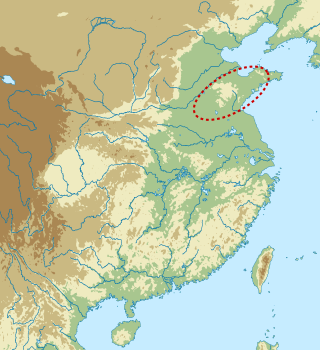
The Yueshi culture was an archaeological culture in the Shandong region of eastern China, dated from 1900 to 1500 BC. It spanned the period from the Late Neolithic to the early Bronze Age. In the Shandong area, it followed the Longshan culture period and was later replaced by the Erligang culture.
